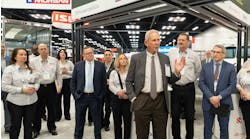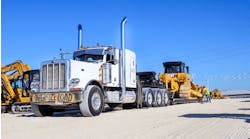Stopping-distance regs were expected to drive adoption of air-disc brakes (ADBs), but it’s looking like concern over weight may be the bigger driver.
“Fuel-economy regulations pose impressive challenges,” says Fabio Jurchaks, engineering manager for Fras-le North America, a manufacturer of friction material for disc and drum brakes. The new greenhouse-gas and fuel-efficiency rules for medium- and heavy-duty vehicles were crafted jointly by the Environmental Protection Agency (EPA) and the National Highway Traffic Safety Administration (NHTSA). Those regs, often called the GHG/MPG rules, will be phased in over the next five years.
For tractor-trailers, the proposed engine and vehicle standards begin in the 2014 model year and establish a 20% reduction in carbon dioxide emissions and fuel consumption by the 2018 model year. Vocational vehicle standards kick in for the 2014 model year as well and target up to a 10% reduction in fuel consumption and carbon dioxide emissions by the 2018 model year.
As a result of that federal rulemaking, OEMs and suppliers alike are exploring a variety of ways to meet those fuel-efficiency targets, including the reduction of component weight.
“Brake systems are sure to be targeted for mass reduction and will need to become smaller yet still handle more work,” Jurchaks explains. “But as thermal mass is reduced, a number of engineering challenges arise with managing extra heat energy while maintaining good brake-pedal feel, lining life and low noise.”
The larger amount of work for brake systems to perform that Jurchaks refers to stems from the regulations NHTSA put in place in 2011 that mandate shorter stopping distances for heavy trucks. Those rules require a “typical” three-axle tandem tractor with GVWR of 59,600 lbs. or less coupled to a trailer and traveling at 60 mph to come to a complete stop within 250 ft. Compared to the former 355 ft. stopping standard, the new rule cuts tractor-trailer stopping distance by roughly 30%.
For heavy, severe-service tractors with GVWRs above 70,000 lbs., the stopping-distance requirement at the same speed is within 310 ft. But there is a caveat: All “heavy truck tractors” must stop within 235 ft. when loaded to what is termed their “lightly loaded vehicle weight.”
Two-axle (4x2) and three-axle (6x4) tractors with GVWRs above 59,600 lbs., however, must meet the 250 ft. at 60 mph rule by Aug. 1, 2013. And heavier severe-service tractors with GVWRs above 70,000 lbs. are required to meet the shorter stopping distance of 310 ft. by that date.
Truck brake engineers emphasize that the majority of tractors—in this case meaning those with tandem rear axles, which account for up to 70% of the highway rig population— can comply with the new stopping distance rule using nothing more exotic than wider “Enhanced S-cam” 16.5-in. drum brakes.
The larger size and design refinements of those brakes dissipate heat more effectively. As a result, they stop trucks within a significantly shorter distance than their predecessors— in many cases to within just several feet of more sophisticated (and more expensive) ADBs.
For example, Steve Bell, engineering manager of wheel end air disc brakes at Bendix Spicer Foundation Brake, notes that based on his company’s test track results, a typical Class 8 highway tractor equipped with ADBs on its steer and drive axles pulling an un-braked fully loaded trailer at 60 mph can come to a complete stop in about 200 ft.
But under the same scenario using ADBs on only the steer axle and enhanced drum brakes on the drive axles, the tractor-trailer stops in 215 ft. If enhanced drum brakes are used on all the tractor wheel end positions, the stopping distance rises to 220 ft. That mere 20-ft. difference can be a telling factor when price gets added to the mix, says Gary Ganaway, director of marketing and global customer solutions at Bendix Spicer Foundation Brake.
“That’s a fairly tight stopping distance cluster where these braking systems are concerned,” he says, pointing out that ADBs typically cost $500 to $1,000 more per axle compared to drums.
HEATING UP But it’s not the entire story, especially when weight gets added to the picture. Ganaway explains that the testing conditions required by NHTSA’s new stopping distance rules are a far cry from the real-world conditions on U.S. roadways.
“Most fleets govern their vehicles above 60 mph, often between 65 and 68 mph, and as a vehicle’s speed goes up, the factor of ‘brake work’ required to stop it goes up as well, often exponentially,” he explains.
The “brake work” Ganaway refers to translates directly into heat, which is the archenemy of drum brakes, says Fras-le’s Jurchaks. “Drum brakes are a wonderfully simplified [product] but they are what we call a ‘closed design,’ meaning that heat created during braking makes dissipation difficult,” he notes. “However, ADBs are an ‘open design,’ meaning the brake pads and rotors are exposed to external air, allowing heat to be easily dissipated and the brake mechanism to stay cool.”
That coolness means the power of an ADB will not fade during a sustained braking event such as traveling down a steep hill, Jurchaks adds. Thus, in order to provide more stopping power to meet NHTSA’s new stopping regulations and counteract the fade at high temperatures, brake makers increased the size and weight of their drum systems. These design changes run counter to what OEMs desire to achieve in order to meet the new GHG-MPG rules.
That’s one of the reasons why Peterbilt Motors decided to make ADBs standard on the steer axles of all of its Class 8 models last year, notes chief engineer Landon Sproull.
“We continue to explore methods to reduce the weight of the vehicle and improve performance, [and for] disc brakes we’re looking at integrating torque plates into the steer axle knuckles,” he points out. “Brake linings are also being tested that are vocation-specific to further enhance performance and [extend the] life of the disc brakes.”
Sproull says that, compared to drum brakes, ADBs also offer improved brake stability, reduced brake fade, elimination of brake pull, and shorter stopping distance. “Tractor-trailers as well as trucks benefit from these attributes as they provide greater control over the vehicle,” he says.
MAINTENANCE SAVINGS
The reduced stopping distances required by NHTSA’s rules also transfer more of the vehicle’s load to the steer axle brakes. “As a result, higher friction brakes are needed primarily on the steer axle, which is why we made them standard,” Sproull adds. “Making disc brakes standard [on the steer axle] was a natural progression of what we see in the marketplace and our belief in the product.”
He also notes that the cost impact of ADBs should be measured over the life of the vehicle, adding that as the next phase of reduced stopping distances goes into effect and as product cost reductions continue to be made, market adoption of ADBs will increase. Matt Creech, North American brake business manager for Meritor, adds that the maintenance savings over time are potentially one of the biggest benefits of ADBs even though, in comparison to drum brake systems, they are far more complicated mechanisms.
“ADBs do not require periodic lubrication like drum brakes do and are far easier to inspect visually because of their open design,” he says. “You don’t have to remove the wheel to inspect them the way you have to do with drum brakes.”
That typically saves three hours of work when it comes to inspecting the brake systems, Creech adds.
While payback calculation on initial investment varies by vocation, Peterbilt’s Sproull says that, as a rule of thumb, ADBs are expected to offer twice the brake life with reduced service costs. “That’s why we’re already seeing strong acceptance of disc brakes in the marketplace with sales approaching 50% in some segments,” he stresses.
Creech explains that some of those segments include refuse trucks, transit buses, and school buses that operate in a heavy stop-and-go environment ideally suited for ADBs.
“ADBs are ideal where vehicles have to make hundreds of stops—especially hard stops—per day,” he says. “But for highway vehicles that make relatively few stops per day, drums will be preferred for the time being. Despite the double-digit growth in ADB sales we’ve seen over the last three to four years, we won’t see them supplant drum brakes in trucking in the near term.”
THE COPPER CONUNDRUM
One issue uppermost in the minds of many brake engineers these days is the impending implementation of new state rules restricting the use of copper in brake pads. According to Fabio Jurchaks, engineering manager for Fras-le North America, California, Washington and Rhode Island are preparing to regulate the use of copper as well as cadmium, chromium, lead, mercury, and asbestos as they are considered “potentially hazardous materials.”
Jurchaks points to several critical milestones within what’s generically being referred to as the “Copper Bill” in brake engineering circles:
- By Jan. 1, 2014, no more than 0.1% by weight of asbestos, cadmium, chromium, lead and mercury will be allowed in the friction material composition.
- By Jan. 1, 2021, copper content will be limited to 5% by weight.
- By Jan. 1, 2025, copper content in California will be limited to 0.5% by weight in the friction material formulation. Jurchaks believes the 2014 milestone should not be a problem since most major manufacturers banned the use of those ingredients years ago.
“The challenge is with the copper limits,” he explains. “Many of the nonasbestos organic pads, called ‘NAO’ or ‘ceramic’ pads, use copper in their composition…and such ceramics are today’s standard for comfortable, low-noise pads.” A natural alternative for the low to no copper rules are semi-metallic or low-metallic pad formulations, but the trade-offs may be higher noise propensity, dust and rotor wear, he says.
“The two paths to follow are low-copper or copper-free NAO/ceramic pads or ‘hybrid’ pads,” Jurchaks points out. “The first still faces high cost issues along with a lack of test data; therefore, trade-offs are unknown for those formulations. With the second, hybrid materials use technologies from NAO and low-semi metallic formulations together.”
This changeover in friction materials creates a possible bump in the road that revolves around customer expectations for decreased noise, vibration, and harshness; expectations that he says are at an all-time high.
Jurchaks also emphasizes that brake-pad designs overall come with many trade-offs in noise, performance, wear and wheel-dust generation. Hence, when certain brake-pad properties are changed, other attributes will be impacted, possibly driving up cost in order to control potentially negative attributes such as excessive noise.
“In addition, customers expect pads and rotors to last a long time and create very little wheel dust. It is important to note that balancing all of these needs within the friction material is no simple science,” Jurchaks stresses. “As friction output increases to provide a better stopping power, noise output, dust, and rotor life are typically degraded.”


